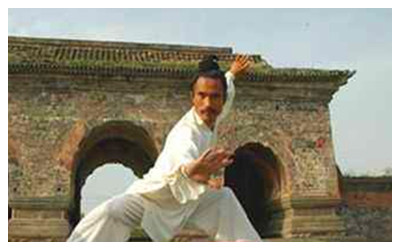Skype: neodalle-travel
Tel: +86 135 7447 2266
E-mail: sales@visitaroundchina.com

 Baguazhang, also known as Eight-Diagram Palm, is a boxing style characterized by continuously changing palm styles. It is also called Youshen Bagua (roving eight-diagram), Longxing Bagua (dragon-shaped eight-diagram), Xingyi Bagua (Xingyi eight-diagram Chuan), Yinyang Bapan Zhang (positive-negative eight-plate palm), etc.
Baguazhang, also known as Eight-Diagram Palm, is a boxing style characterized by continuously changing palm styles. It is also called Youshen Bagua (roving eight-diagram), Longxing Bagua (dragon-shaped eight-diagram), Xingyi Bagua (Xingyi eight-diagram Chuan), Yinyang Bapan Zhang (positive-negative eight-plate palm), etc.
History of Baguazhang
Eight-Diagram Palm was created by Dong Haichuan who combined Chinese Kung Fu and Neigong (exercises benefiting the internal organs). It develops on the traditions of Chinese Kung Fu that attaches importance to the fist styles as well as the beeline fighting route. The deft and swift changing styles perfectly ward off the attacks of the enemy. The distance and directions between the opponents can be well adjusted to optimal situations. A proverb describes this Kung Fu style as: It is like a swimming dragon as changing styles, a guarding ape as concentrating, a squatted tiger as sitting and a hovering eagle as walking.
Features of Baguazhang
The eight-diagram palm is based on the old Chinese philosophy of eight combinations of three whole and broken lines used in divination. While practising, the practitioner moves according to the eight diagrams. There are eight basic palm plays. A total of 64 palm tricks and moves have come from the original eight basic palm plays. Apart from solo practices, there are also sparrings, Sanshou (free sparring) and fighting with weapons, such as Bagua sword play, Bagua sabre play and Bagua cudgel play, and Bagua play of shaft decorated with seven stars, etc. While practising these routines, practitioners rove around like a dragon moving amidst clouds.
Bagua Zhang features dexterity and agility. When moving around it is like walking in a muddy place, with foot steps changing all the time like running water. Palm tricks and body movements follow one after another. The roving around looks like endless circles which overlap one another. The body turns around from the waist during walking, roving, turning, rising and falling. Palm tricks change with the movements of the body. When the upper body protrudes, the lower part of the body squats back to keep balance. When the arms are sent out, the feet are drawn back. When moving it is like a roaming dragon; when squatting it is like a sitting tiger; when looking around it is like a monkey on the lookout; when roving it is like a circling eagle.
Styles of Baguazhang
Yin style was created by an apprentice of Dong Haichuan named Yin Fu. The extending hand is called Ox Tongue Palm which consists of sixty-four styles. The basic skills are created according to the ideology of traditional Chinese Eight Diagrams. They may have the same names as other styles, but show different forms and skills.
 Ask Questions ?
Ask Questions ?